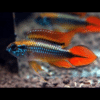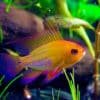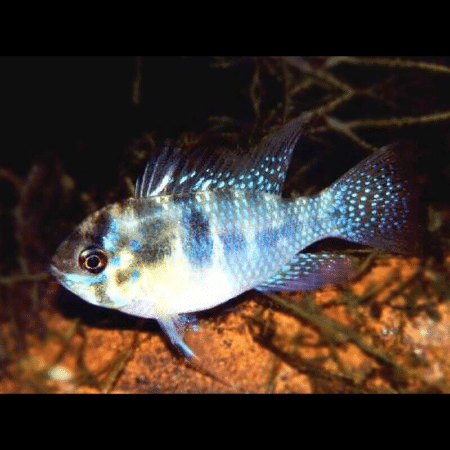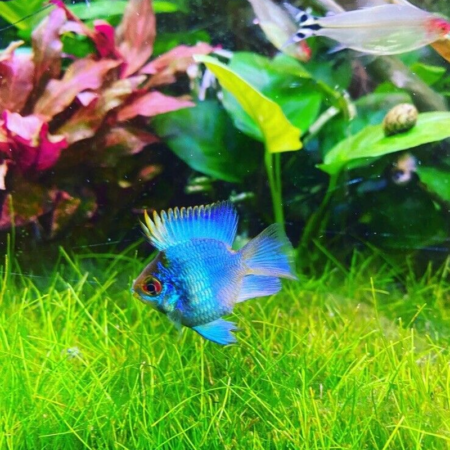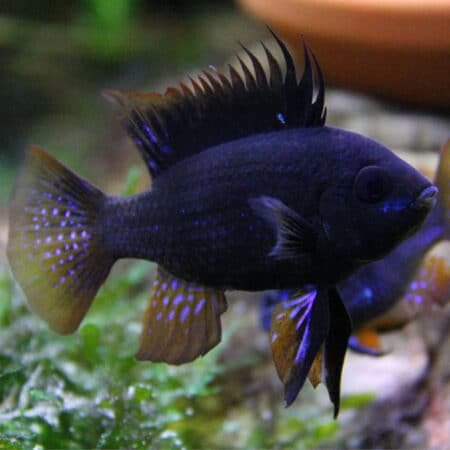Subtotal: £18.39
1 Pair male and female Ramirezi Red Gold – Stunning Variant! South American Dwarf Cichlid (2 FISH ), Enhance Your Aquarium with These Graceful Companions and Their Stunning Colors
£20.49 Original price was: £20.49.£17.42Current price is: £17.42.
Welcome these stunning Ramirezi Red Gold cichlids into your aquarium! With vibrant red and gold hues, they add beauty to any aquatic display. These peaceful companions thrive in community tanks, showcasing their gentle nature. Includes one male and one female for your enjoyment.
Species Introduction
Essential Care Guide for Your 1 Pair Male and Female Ramirezi Red Gold – Stunning Variant! South American Dwarf Cichlid (2 FISH)
| Optimal Living Conditions | |
|---|---|
| Water Temperature | 24-27°C (75-81°F) |
| pH Level | 6.5-7.5 |
| Water Hardness | 4-12 dKH |
| Minimum Tank Size | 80L (20 gal) |
| Salinity | Freshwater |
| Care Level | Beginner Friendly |
Care Requirements Dashboard
✓ Care Level: Easy
| Parameter | Ideal Range |
|---|---|
| Tank Size | 20 gallons minimum |
| pH Level | 6.0 – 7.5 |
| Temperature | 78°F – 85°F |
| Hardness | 2 – 12 dGH |
Natural Behavior & Temperament
The Ramirezi Red Gold is known for its peaceful and sociable nature, making it an ideal candidate for community tanks. These fish display a range of natural behaviors, including playful swimming patterns and territorial displays, especially during breeding. They are generally non-aggressive but may exhibit some territoriality, particularly when establishing breeding sites. Observing their interactions can be quite rewarding, as they often form strong pair bonds and engage in intricate courtship rituals. Their social nature allows them to coexist harmoniously with other peaceful species, provided that the tank is spacious enough and includes plenty of hiding spots and territories. They thrive in environments where they can explore and interact, making them a delightful addition to any aquarium setup.
Tank Setup Guide
Creating an ideal habitat for your Ramirezi Red Gold involves replicating their natural environment as closely as possible. A well-planted aquarium with plenty of hiding spots is essential for their comfort and security. Use a fine substrate, such as sand or small gravel, which allows them to forage naturally. Incorporate live plants like Java Fern, Anubias, and Amazon Swords, which not only provide cover but also enhance the aesthetics of the tank. Additionally, include driftwood and rocks to create caves and territories, as these fish enjoy exploring and establishing their own space. Ensure that the tank is well-cycled and equipped with a reliable filtration system to maintain optimal water quality. A gentle water flow is preferred, as strong currents can stress these delicate fish. Lastly, consider adding a soft light source to mimic their natural habitat, promoting plant growth and creating a serene environment for your aquatic companions.
Water Quality Management
Maintaining optimal water quality is crucial for the health and well-being of your Ramirezi Red Gold. Regular testing of water parameters is essential to ensure that they remain within the ideal ranges. Aim for a pH level between 6.0 and 7.5, as this closely resembles their natural habitat. The temperature should be kept between 78°F and 85°F, with a stable environment being key to their comfort. Additionally, monitor the hardness of the water, which should be between 2 and 12 dGH. Performing regular water changes of 20-30% weekly will help to keep the water clean and reduce the buildup of harmful toxins. Use a high-quality water conditioner to remove chlorine and chloramines from tap water before adding it to the aquarium. Keeping an eye on ammonia, nitrite, and nitrate levels is also important, as elevated levels can lead to stress and health issues. By providing a stable and clean environment, you will ensure that your Ramirezi Red Gold thrive and display their vibrant colors.
Feeding & Nutrition
The dietary needs of the Ramirezi Red Gold are relatively straightforward, as they are classified as omnivorous fish. A well-balanced diet is essential for their health, growth, and vibrant coloration. High-quality flake or pellet food specifically designed for cichlids should form the basis of their diet. Supplement their diet with frozen or live foods, such as brine shrimp, bloodworms, and daphnia, to provide essential nutrients and encourage natural foraging behavior. Offering a variety of foods will not only enhance their health but also stimulate their natural instincts. It is recommended to feed them small amounts 2-3 times a day, ensuring that they consume all the food within a few minutes to prevent water quality issues. Additionally, incorporating vegetable matter, such as blanched spinach or spirulina, can provide essential vitamins and minerals. By adhering to a balanced feeding regimen, you will promote the overall health and well-being of your aquatic companions.
Compatibility Guide
When considering tank mates for your Ramirezi Red Gold, it is important to choose peaceful species that can coexist harmoniously in a community tank. Ideal companions include other dwarf cichlids, tetras, rasboras, and peaceful bottom dwellers like Corydoras catfish. Avoid aggressive species, such as larger cichlids or fin-nippers, as they can stress or harm your Ramirezi. Additionally, ensure that the tank is spacious enough to accommodate the different species and provide hiding spots to reduce territorial disputes. A well-planned community aquarium will allow your Ramirezi Red Gold to thrive while interacting with a variety of other fish friends. Regular monitoring of their behavior will help to identify any compatibility issues early on, allowing for adjustments as needed to maintain a peaceful environment.
Tank Mate Compatibility Guide
Great Tank Mates
- Other dwarf cichlids
- Tetras
- Rasboras
- Corydoras catfish
Avoid These Tank Mates
- Larger cichlids
- Fin-nippers
Compatibility Note: Always research specific species requirements and observe fish behavior when introducing new tank mates. Individual fish personalities can vary!
Health & Wellness
Ensuring the health and wellness of your Ramirezi Red Gold is paramount for their longevity and happiness. Regular observation of their behavior and physical appearance is essential to detect any signs of stress or illness. Common health issues include ich, fin rot, and swim bladder disease, which can often be prevented through proper care and water quality management. Maintain a stable environment with appropriate water parameters to minimize stress and susceptibility to disease. Quarantine any new fish before introducing them to your main tank to prevent the spread of pathogens. In case of illness, prompt treatment is crucial; consult a veterinarian or aquarist for appropriate medications and care protocols. Additionally, providing a varied diet rich in nutrients will support their immune system and overall vitality. By prioritizing their health, you can enjoy the beauty and companionship of your Ramirezi Red Gold for years to come.
Breeding Information
Breeding Ramirezi Red Gold can be a rewarding experience, as these fish are known for their attentive parental care. To encourage breeding, provide a separate breeding tank that mimics their natural habitat, complete with fine substrate and plenty of hiding spots. The ideal temperature for breeding is slightly elevated, around 82°F to 84°F. Once the pair has formed a bond, they will seek out a flat surface to lay their eggs, which can number in the hundreds. After spawning, the female will guard the eggs while the male protects the territory. The eggs typically hatch within 24 to 48 hours, and the fry will become free-swimming in about a week. During this time, it is essential to provide infusoria or finely crushed flake food to support their growth. The parents will continue to care for the fry, guiding them to food sources and protecting them from potential threats. By providing a nurturing environment and monitoring their progress, you can successfully raise the next generation of Ramirezi Red Gold.
Acclimation Process
Introducing your Ramirezi Red Gold to a new tank requires a careful acclimation process to minimize stress and ensure a smooth transition. Begin by floating the sealed bag containing the fish in the aquarium for about 15-20 minutes, allowing the temperature to equalize. After this, gradually introduce small amounts of tank water into the bag over the course of an hour. This process helps the fish adjust to the new water parameters. Once acclimated, gently release the fish into the tank using a net to avoid adding any transport water that may contain harmful substances. Observe their behavior closely for the first few days, ensuring they are adjusting well to their new environment. By following these steps, you can help your Ramirezi Red Gold settle into their new home comfortably.
Long-term Care
Caring for your Ramirezi Red Gold over the long term involves maintaining a stable and healthy environment. As these fish can live for 3 to 5 years with proper care, it is essential to monitor their growth and adjust their habitat as needed. Regular water changes and parameter checks will help to keep the environment suitable for their needs. Additionally, observe their behavior and interactions with other tank mates to ensure that they remain stress-free. As they age, you may notice changes in their activity levels and feeding habits, which can be normal. Providing a varied diet and maintaining optimal water conditions will support their health throughout their lifespan. By prioritizing their care, you can enjoy the beauty and companionship of your Ramirezi Red Gold for many years to come.
Natural Habitat Recreation
Recreating the natural habitat of the Ramirezi Red Gold in your aquarium can enhance their well-being and promote natural behaviors. Focus on creating a biotope that mimics the slow-moving waters of their native environment, incorporating soft, sandy substrates and plenty of live plants. Use driftwood and rocks to create hiding spots and territories, allowing them to feel secure. Ensure that the lighting is gentle, as bright lights can be stressful for these fish. Incorporating floating plants can also provide shaded areas, mimicking the dappled light conditions found in their natural habitat. By designing an aquarium that closely resembles their natural environment, you will encourage healthy behaviors and enhance the overall aesthetic of your tank.
Seasonal Care Adjustments
As seasons change, so too should your care routine for your Ramirezi Red Gold. During warmer months, monitor the water temperature closely, as higher temperatures can stress these fish. Ensure that the tank is not exposed to direct sunlight, which can cause overheating. In contrast, during cooler months, consider using a heater to maintain a stable temperature within the ideal range. Additionally, adjust your feeding schedule to account for changes in activity levels; fish may be more active and require more food during warmer months. Regularly check water parameters to ensure they remain stable throughout the seasons. By making these adjustments, you can provide optimal care for your Ramirezi Red Gold year-round.
Expert Tips
For those looking to enhance their experience with Ramirezi Red Gold, consider these expert tips. First, invest in a quality water testing kit to monitor parameters accurately. Maintaining stable water conditions is crucial for their health. Second, provide a varied diet to promote vibrant coloration and overall vitality. Third, observe their behavior regularly to identify any signs of stress or illness early on. Lastly, consider joining online forums or local aquarium clubs to connect with other enthusiasts who can offer valuable insights and support. By following these tips, you can ensure a fulfilling and successful experience caring for your Ramirezi Red Gold.
Troubleshooting
Encountering challenges while caring for your Ramirezi Red Gold is not uncommon, but being prepared can help you address issues promptly. Common problems include stress from aggressive tank mates, poor water quality, or inadequate hiding spots. If you notice signs of stress, such as hiding or loss of appetite, assess the tank environment and make necessary adjustments. If health issues arise, such as white spots or frayed fins, consider isolating affected fish and treating them in a quarantine tank. Regular maintenance and observation will go a long way in preventing many common problems. By staying vigilant and proactive, you can ensure the health and happiness of your Ramirezi Red Gold.
Scientific Background
The Ramirezi Red Gold belongs to the family Cichlidae, which encompasses a diverse range of freshwater fish known for their complex behaviors and vibrant colors. This species is a popular choice among aquarists due to its manageable size and peaceful temperament. Research indicates that dwarf cichlids, including the Ramirezi, exhibit fascinating social structures and parental care behaviors, making them a subject of interest in the aquarium hobby. Conservation efforts are essential to protect their natural habitats, as pollution and habitat destruction pose significant threats to their populations in the wild. By understanding their scientific background, aquarists can better appreciate the beauty and complexity of these remarkable fish.
Advanced Care Techniques
For experienced aquarists looking to take their care of Ramirezi Red Gold to the next level, consider implementing advanced techniques. One method is to create a breeding setup that mimics their natural conditions, including specific water parameters and environmental cues that trigger spawning. Additionally, experimenting with different dietary supplements can enhance coloration and health. Regularly rotating tank mates can also provide social stimulation and reduce territorial disputes. Lastly, keeping detailed records of water parameters, feeding schedules, and behavioral observations can help you identify patterns and make informed adjustments to their care. By employing these advanced techniques, you can foster a thriving environment for your Ramirezi Red Gold.
Water Quality Parameters
Optimal Range
24-27°C
6.5-7.5
0 ppm
Caution Zone
22-24°C or 27-29°C
6.0-6.5 or 7.5-8.0
0.25-0.5 ppm
Danger Zone
<22°C or >29°C
<6.0 or >8.0
>0.5 ppm
Monitoring Tip: Test water parameters weekly and perform regular water changes to maintain optimal conditions for your aquatic friends!
Frequently Asked Questions
Q: What tank size is required for Ramirezi Red Gold?
Ramirezi Red Gold cichlids thrive in a minimum tank size of 100 litres. They are relatively small fish but require ample swimming space and hiding spots. A larger tank allows for better water quality and stability, which is crucial for their health. It is advisable to keep a pair in a tank where they can establish territories. Additionally, providing plants and decorations will enhance their environment and reduce stress, allowing them to exhibit their natural behaviours.
✓ Expert Tip
Ensure your tank is well-filtered and regularly maintained to keep the water parameters stable.
Q: What water parameters do Ramirezi Red Gold require?
Ramirezi Red Gold prefer soft, slightly acidic water, ideally with a pH between 6.0 and 7.0. The water hardness should be between 5-15 dGH, and the temperature should be maintained between 24-28°C. Regular testing of water parameters is essential to ensure a stable environment. Sudden changes can stress your fish, leading to health issues. Consider using a high-quality water conditioner and performing regular water changes to maintain optimal conditions.
✓ Expert Tip
Utilise a reliable water testing kit to monitor parameters regularly and ensure the health of your aquatic companions.
Q: How often should I feed Ramirezi Red Gold?
Feed your Ramirezi Red Gold cichlids 2-3 times per day, offering only as much food as they can consume in a few minutes. A varied diet is vital for their health; include high-quality flake food, pellets, and occasional live or frozen foods such as brine shrimp or bloodworms. This variety not only promotes their vibrant colours but also ensures they receive all necessary nutrients. Overfeeding can lead to water quality issues, so be mindful of the amounts you provide.
✓ Expert Tip
Consider using feeding rings to prevent food from scattering and to help monitor consumption.
Q: What are the best tank mates for Ramirezi Red Gold?
Ramirezi Red Gold are generally peaceful but can be territorial during breeding. Suitable tank mates include smaller, non-aggressive species such as tetras, rasboras, and certain types of catfish. Avoid larger or aggressive fish that may intimidate or harm them. It’s crucial to ensure that all fish in the tank have ample space and hiding spots to reduce stress and aggression. Monitoring interactions during the initial introduction is essential for ensuring compatibility.
✓ Expert Tip
Introduce new fish gradually and observe their behaviour to ensure a harmonious community.
Q: How do I properly acclimatise Ramirezi Red Gold to my aquarium?
Acclimatising your Ramirezi Red Gold is vital for their health. Begin by floating the sealed bag in your aquarium for approximately 15-20 minutes to equalise temperature. After this, gradually introduce small amounts of aquarium water into the bag every 5 minutes for about an hour. This process helps them adjust to the water chemistry. Once acclimatised, gently place them into the aquarium using a net to avoid adding bag water, which may contain toxins.
✓ Expert Tip
Always ensure your aquarium conditions are stable before introducing new fish.
Q: What are the signs of healthy Ramirezi Red Gold?
Healthy Ramirezi Red Gold exhibit vibrant colours, active swimming behaviour, and a strong appetite. Their fins should be fully extended and free from tears or lesions. Observe their behaviour; they should interact with their environment and display natural behaviours such as exploring and hiding. If you notice lethargy, loss of colour, or refusal to eat, these may indicate stress or health issues. Regular monitoring and maintaining water quality are essential for their well-being.
✓ Expert Tip
Regularly check for signs of disease, such as white spots or abnormal behaviour, to address issues promptly.
Q: How do I successfully breed Ramirezi Red Gold?
Breeding Ramirezi Red Gold can be a rewarding experience. To encourage breeding, ensure the tank is well-maintained with stable water conditions. Provide flat surfaces like rocks or spawning cones for egg laying. The female will lay eggs, which the male will fertilise. After hatching, the parents will guard the fry. It is crucial to remove other fish from the tank during this period to prevent predation. Feeding the fry with finely crushed flakes or specially formulated fry food will support their growth.
✓ Expert Tip
Monitor the parents during breeding; they may become aggressive towards other tank mates.
Q: What substrate is most suitable for Ramirezi Red Gold?
Ramirezi Red Gold prefer a fine-grained substrate, such as sand, which mimics their natural habitat in South America. This substrate allows them to dig and forage, which is crucial for their behaviour and well-being. Additionally, a dark substrate can enhance their vibrant colours. Incorporating plants and decorations into the substrate will create a more natural environment, providing hiding spots and reducing stress.
✓ Expert Tip
Avoid sharp substrates that may injure their delicate fins.
Q: What behavioural patterns should I expect from Ramirezi Red Gold?
Ramirezi Red Gold are known for their lively and inquisitive nature. They often display social interactions, especially during breeding, where the male may exhibit more vibrant colours and perform courtship displays. They enjoy exploring their environment and may dig in the substrate. Providing plenty of hiding spots will help them feel secure, reducing stress. It’s important to observe their behaviour regularly, as changes may indicate stress or health issues.
✓ Expert Tip
Encourage natural behaviours by adding plants and caves to their environment.
Q: How can I prevent common diseases in Ramirezi Red Gold?
Preventing diseases in Ramirezi Red Gold involves maintaining excellent water quality and a stress-free environment. Regular water changes and monitoring parameters are essential. Quarantine new fish before introducing them to prevent disease transmission. Additionally, avoid overfeeding to reduce waste and maintain water clarity. Observe your fish for any signs of illness, such as abnormal swimming, loss of appetite, or visible lesions, and address any issues immediately.
✓ Expert Tip
Consider adding natural treatments to promote overall health and immunity.
Q: What lighting conditions do Ramirezi Red Gold prefer?
Ramirezi Red Gold thrive in moderate lighting. Bright lights can cause stress, so using subdued or adjustable lighting is advisable. They appreciate a natural light cycle, with about 10-12 hours of light per day. Providing shaded areas through plants and decorations will help them feel secure. This balance of light not only promotes their health but also enhances their vibrant colours.
✓ Expert Tip
Use LED lights with a dimming feature to easily adjust the brightness as needed.
Q: How do I recognise stress in Ramirezi Red Gold?
Signs of stress in Ramirezi Red Gold include hiding excessively, loss of colour vibrancy, and erratic swimming patterns. They may also exhibit aggressive behaviour towards tank mates or become lethargic. Changes in feeding habits, such as refusing food, are significant indicators of stress. It is vital to identify and rectify the causes of stress, such as poor water quality, incompatible tank mates, or abrupt changes in their environment.
✓ Expert Tip
Maintain a stable environment and minimise disturbances to help reduce stress levels.
Q: What natural habitat conditions should I replicate for Ramirezi Red Gold?
To replicate their natural habitat, aim for a well-planted tank with a soft substrate and plenty of hiding spots. In the wild, they inhabit slow-moving waters with dense vegetation, so incorporating live plants, driftwood, and rocks will create a comfortable environment. Maintain a slightly acidic pH and warm water temperature to mimic their native conditions. Providing a well-structured layout will encourage natural behaviours and reduce stress for your aquatic companions.
✓ Expert Tip
Regularly trim plants to maintain a balanced environment and ensure adequate swimming space.



